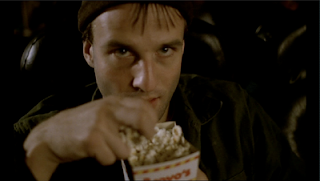The Sinful Dwarf (1973)
 Vidal Raski's crazed Danish exploitation feature The Sinful Dwarf/Dværgen.
Vidal Raski's crazed Danish exploitation feature The Sinful Dwarf/Dværgen.
Starring: Torben Bille, Anne Sparrow, Tony Eades, Clara Keller and Werner Hedman.
It's time to lower the tone here at 42nd Street Cinema, which can only a good thing. I love a good grimy exploitation flick and among the slew of perverted exploitation pictures made in the 1970s, there are a select few standout titles, these are the ones that encapsulate that dirty, rotten and downright nasty essence we exploitation cinephiles seek. Films such as, Thriller: A Cruel Picture/Thriller - en grym film (1974) and The Sinful Dwarf (1973).
I was beginning to have preconceived notions after reading about the film and how it 'goes too far' with cinematic acceptability. So, when I finally sat down to watch this long lost nugget of 70s sleaze, I couldn't help but wonder if it would be overhyped and whether I should set myself up to be let down.
I wouldn't go as far as saying it's the sleaziest or most offensive movie ever made, but it's certainly safe to say The Sinful Dwarf is a winner. It's a scuzzy and powerful flick with several genuinely uncomfortable scenes.



Torben Bille portrays Olaf, the gimp legged dwarf, who lures young girls into his eccentric mother's guesthouse. Once inside the house, they are subdued with heroin, chained up in the attic and sold as sex slaves. This is all fundamentally established within a grueling pre-opening credit sequence of the movie. In which we see Olaf shambling down an empty street, carrying a teddy bear and a motorized poodle. Upon passing a young girl playing hopscotch by herself, the dwarf places the poodle on the floor. The young girl interrupts her game and appears to be entranced by the toy. As she picks it up, the dwarf takes the other end of the lead that is attached to the small toy and leads her back to his mother's house.
I think what makes the sequence even more disturbing is that it, aside from the dwarf's manipulation and eventual abduction of the girl, is when you begin to question the girl's age. As the actress is clearly in her twenties, her character's attire suggests she is of a much younger age, around that of a ten or or eleven year old. This is further exacerbated by her interest in the poodle toy and is more suggestive of her true mental age.
Olaf and the girl enter the house, he closes the door before eerily telling her that he has, "more toys upstairs". Following her up to one of the upstairs rooms, as her back is turned he hits her over the head with his cane. The weird credit sequence then ensues with motorized toys accompanied by a strange repetitive jangling sound.

The following scene depicts the dwarf disemboweling the teddy bear with a knife, in order to remove a small packet of heroin from inside. We later learn that it is supplied by a bearded fellow aptly named Santa Claus (Hedman), who owns a toy shop.
Enter the newlywed couple, Mary (Sparrow) and Peter Davis (Eades). The newlyweds are trying to find a place to live, since Peter is attempting to find his footing with television writing and Mary is a housewife, the two are practically broke. Previously turning down a place for £10 a week, they find themselves knocking on the door of Lila Lashe's (Keller) guesthouse. Peter talks to Lila, at first she informs him that there are not vacancies, but once Mary walks into shot, Lila's tune dramatically changes. Retracting her previous statement, she tells Peter that there is a room they can have for £6 a week.
It'll be a while until the couple truly understand what Lila and her dwarf son are hiding in their squalid attic. Until that point, the film is padded out with complete absurdities, such as Lila's peculiar cabaret acts, to which Olaf accompanies her on the piano and numerous scenes of 'Johns' taking advantage of the captive girls. Including a few dirty XXX close ups, which reminded me of the hardcore inserts seen in Thriller: A Cruel Picture. Purely because they're completely unnecessary and the film hardly benefits from having them.
The Sinful Dwarf is probably the scummiest exploitation picture to come out of Denmark in the 70s. The set is so decrepit and stained, that it deepens to the film's already strong grimy atmosphere. Torben Bille is perfect as the ever-grinning maniacal dwarf, especially when he finally gets his mitts on Sparrow's character Mary. I almost forgot to mention how much he resembles a compacted version of Jack Black.
If you are a fan of exploitation movies, then you need to see this!

































